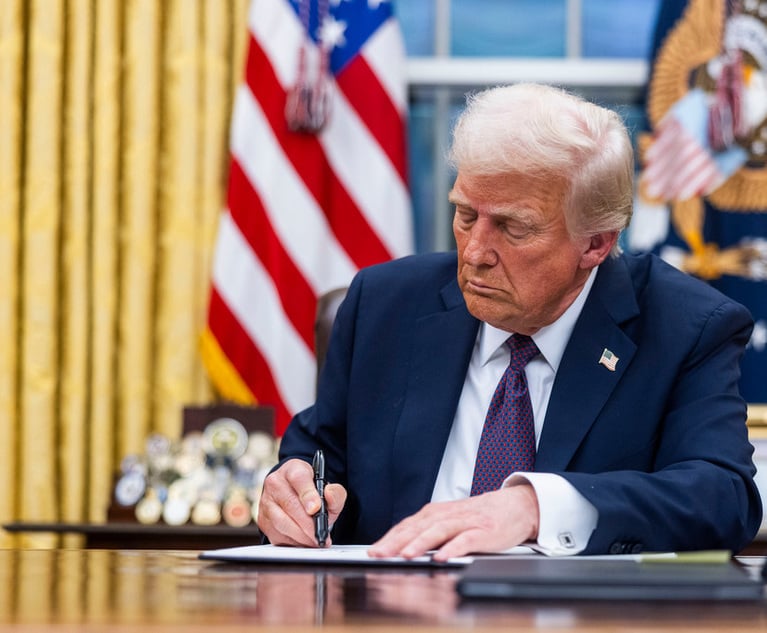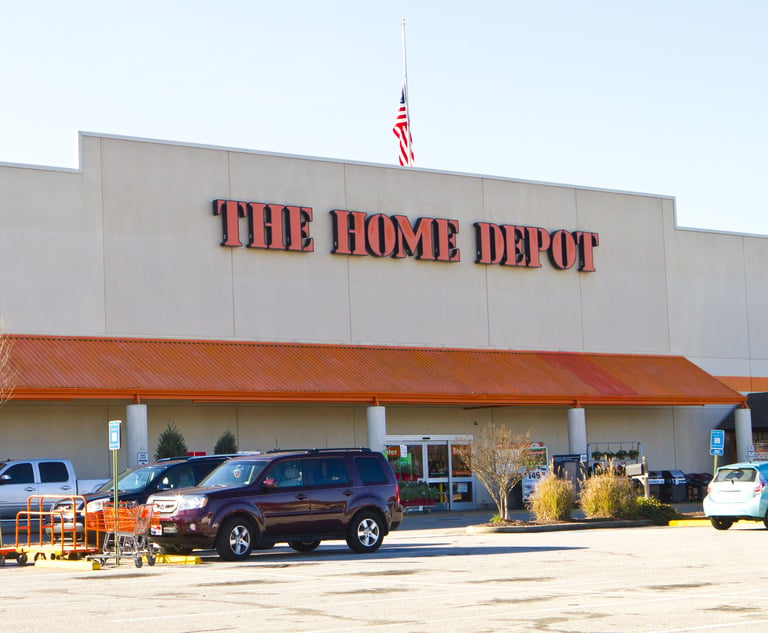Alex Kozinski Harassment Allegations Were 'Gut Punch,' Kavanaugh Tells Senate
"It was a gut punch for me. It was a gut punch for the judiciary. I was shocked, and disappointed, angry, swirl of emotions," Kavanaugh testified Wednesday about when he learned of the sexual harassment claims against Alex Kozinski of the Ninth Circuit.
September 05, 2018 at 12:09 PM
6 minute read
 Brett Kavanaugh, U.S. Supreme Court associate justice nominee for U.S. President Donald Trump, speaks during a Senate Judiciary Committee confirmation hearing in Washington, D.C., on Wednesday. Credit: Aaron P. Bernstein/Bloomberg
Brett Kavanaugh, U.S. Supreme Court associate justice nominee for U.S. President Donald Trump, speaks during a Senate Judiciary Committee confirmation hearing in Washington, D.C., on Wednesday. Credit: Aaron P. Bernstein/Bloomberg
On the second day of his confirmation hearing Wednesday, U.S. Supreme Court nominee Brett Kavanaugh plunged into controversial issues, answering questions ranging from abortion rights to gun control and the scandal surrounding Judge Alex Kozinski for whom he once clerked.
The hearing was interrupted by protesters as it was on Tuesday, but soon the proceedings settled down as the questioning from senators began.
Kavanaugh seemed at ease with the back-and-forth, waving a dog-eared copy of the U.S. Constitution as he repeatedly promised to adhere to precedent and the independence of the judiciary. “No one is above the law,” Kavanaugh said.
Republican senators portrayed Kavanaugh as an open-minded judge who has ruled for and against corporate interests. Democrats grilled Kavanaugh on social issues, and examined his time in the George W. Bush White House.
What follows are some highlights from Kavanaugh's responses to questions:
➤➤ On the precedent of Roe v. Wade: “Roe is settled law as a precedent entitled to respect. It has been reaffirmed many times over 45 years, most prominently in 1992 in Casey. Casey reaffirmed Roe based on stare decisis factors. Casey is precedent on precedent. It's not as if it's just a run-of-the-mill case that was decided and never been reconsidered, but Casey specifically reconsidered it, applied the stare decisis factors and decided to reaffirm it. That makes Casey a precedent on precedent.” He also said that adhering to precedent is “the foundation of our system.” He noted in a dialogue with Sen. Dianne Feinstein, the ranking Democrat on the Senate Judiciary Committee: “I don't live in a bubble. I understand the importance of the issue.” Numerous cases that seek to restrict the abortion right are playing out in federal trial and appellate courts now.
➤➤ Kavanaugh said he was “shocked” by the harassment allegations against now-retired Judge Alex Kozinski of the Ninth Circuit, for whom he clerked. Kavanaugh said he was not aware of the allegations against Kozinski until they surfaced last year in a Washington Post report. “When they became public, the first thought I had [was] no one should be subjected to sexual harassment in the workplace ever, including in the judiciary, especially in the judiciary. When I heard, it was a gut punch. It was a gut punch for me. It was a gut punch for the judiciary. I was shocked, and disappointed, angry, swirl of emotions.”
Kavanaugh praised the judiciary's effort to address sexual harassment through a working group and new reporting mechanisms. “I'm interested in doing everything I can to assist those efforts to make those workplaces safe,” he said. He added: “It's part of a broader national problem.”
➤➤ Kavanaugh touted his hiring of women law clerks. “I made sure, talking with professors at law schools, that I want to see a broad pool of well-qualified applicants, including women.” Kavanaugh said he confronted a “pipeline problem,” and pushed law school professors to break through it. “If confirmed to the Supreme Court, I will continue to do this. What it takes is just not accepting the same old answer, 'Oh, there is a disparity.' Well why, and then do something about it.” More than half of Kavanaugh's law clerks were females.
➤➤ Sen. Patrick Leahy, D-Vermont, confronted Kavanaugh over his relationship during the Bush years with a Republican staffer who reportedly stole emails showing Democratic members' communication about judicial nominees. Kavanaugh at his 2006 hearing denied knowingly receiving any stolen communication. Leahy showed Kavanaugh emails in which the staffer did provide stolen communication. “You weren't concerned with how Mr. Miranda got them?” Leahy asked. Kavanaugh said it was common for White House staffers to communicate with legislative staff about pending nominees. Kavanaugh testified that he did not know he was dealing with anything that was stolen. The hearing devolved into a match between Judiciary Chairman Chuck Grassley and Leahy over whether which records were marked “committee confidential” and those that can be freely discussed.
➤➤ On the Second Amendment, which Justice Clarence Thomas has called an “orphan” at the high court. “I fully understand the gang violence, gun violence, drug violence that has plagued various cities, including Washington, D.C. This was known as the murder capital of the world for a while, this city, and there was a lot of handgun violence at the time. And so I understand the issue, but as a judge my job, as I saw it, was to follow the Second Amendment opinion of the Supreme Court whether I agreed with it or disagreed with it.” When Feinstein asserted that assault weapons are not in “common use,” and therefore should not be protected under the Second Amendment, Kavanaugh replied, “I concluded that it could not be distinguished as a matter of law semi-automatic rifles from semi-automatic handguns, and semi-automatic rifles are widely possessed in the United States. There are millions and millions and millions of semi-automatic rifles that are possessed, so that seemed to fit 'common use' in not being a dangerous and unusual weapon. That was the basis of my dissent.”
Read more:
New Book Tells Inside Stories of Feuding Justices, Anger Toward Trump
Spurning 'Angry Calls,' Lisa Blatt Raves About Kavanaugh, and Urges Confirmation
'Team of 9': Brett Kavanaugh's Confirmation Hearing Remarks
'Who Is Bill Burck?' Not the Only Big Law Attorney Reviewing Kavanaugh Documents
Brett Kavanaugh Returns to the Hot Seat: What We Learned, and What's Next
This content has been archived. It is available through our partners, LexisNexis® and Bloomberg Law.
To view this content, please continue to their sites.
Not a Lexis Subscriber?
Subscribe Now
Not a Bloomberg Law Subscriber?
Subscribe Now
NOT FOR REPRINT
© 2025 ALM Global, LLC, All Rights Reserved. Request academic re-use from www.copyright.com. All other uses, submit a request to [email protected]. For more information visit Asset & Logo Licensing.
You Might Like
View All
Is 1st Circuit the New Center for Trump Policy Challenges?

Insurance Policies Don’t Cover Home Depot's Data Breach Costs, 6th Circuit Says

'Religious Discrimination'?: 4th Circuit Revives Challenge to Employer Vaccine Mandate
2 minute read
Standing Spat: Split 2nd Circuit Lets Challenge to Pfizer Diversity Program Proceed
Trending Stories
Who Got The Work
J. Brugh Lower of Gibbons has entered an appearance for industrial equipment supplier Devco Corporation in a pending trademark infringement lawsuit. The suit, accusing the defendant of selling knock-off Graco products, was filed Dec. 18 in New Jersey District Court by Rivkin Radler on behalf of Graco Inc. and Graco Minnesota. The case, assigned to U.S. District Judge Zahid N. Quraishi, is 3:24-cv-11294, Graco Inc. et al v. Devco Corporation.
Who Got The Work
Rebecca Maller-Stein and Kent A. Yalowitz of Arnold & Porter Kaye Scholer have entered their appearances for Hanaco Venture Capital and its executives, Lior Prosor and David Frankel, in a pending securities lawsuit. The action, filed on Dec. 24 in New York Southern District Court by Zell, Aron & Co. on behalf of Goldeneye Advisors, accuses the defendants of negligently and fraudulently managing the plaintiff's $1 million investment. The case, assigned to U.S. District Judge Vernon S. Broderick, is 1:24-cv-09918, Goldeneye Advisors, LLC v. Hanaco Venture Capital, Ltd. et al.
Who Got The Work
Attorneys from A&O Shearman has stepped in as defense counsel for Toronto-Dominion Bank and other defendants in a pending securities class action. The suit, filed Dec. 11 in New York Southern District Court by Bleichmar Fonti & Auld, accuses the defendants of concealing the bank's 'pervasive' deficiencies in regards to its compliance with the Bank Secrecy Act and the quality of its anti-money laundering controls. The case, assigned to U.S. District Judge Arun Subramanian, is 1:24-cv-09445, Gonzalez v. The Toronto-Dominion Bank et al.
Who Got The Work
Crown Castle International, a Pennsylvania company providing shared communications infrastructure, has turned to Luke D. Wolf of Gordon Rees Scully Mansukhani to fend off a pending breach-of-contract lawsuit. The court action, filed Nov. 25 in Michigan Eastern District Court by Hooper Hathaway PC on behalf of The Town Residences LLC, accuses Crown Castle of failing to transfer approximately $30,000 in utility payments from T-Mobile in breach of a roof-top lease and assignment agreement. The case, assigned to U.S. District Judge Susan K. Declercq, is 2:24-cv-13131, The Town Residences LLC v. T-Mobile US, Inc. et al.
Who Got The Work
Wilfred P. Coronato and Daniel M. Schwartz of McCarter & English have stepped in as defense counsel to Electrolux Home Products Inc. in a pending product liability lawsuit. The court action, filed Nov. 26 in New York Eastern District Court by Poulos Lopiccolo PC and Nagel Rice LLP on behalf of David Stern, alleges that the defendant's refrigerators’ drawers and shelving repeatedly break and fall apart within months after purchase. The case, assigned to U.S. District Judge Joan M. Azrack, is 2:24-cv-08204, Stern v. Electrolux Home Products, Inc.
Featured Firms
Law Offices of Gary Martin Hays & Associates, P.C.
(470) 294-1674
Law Offices of Mark E. Salomone
(857) 444-6468
Smith & Hassler
(713) 739-1250










